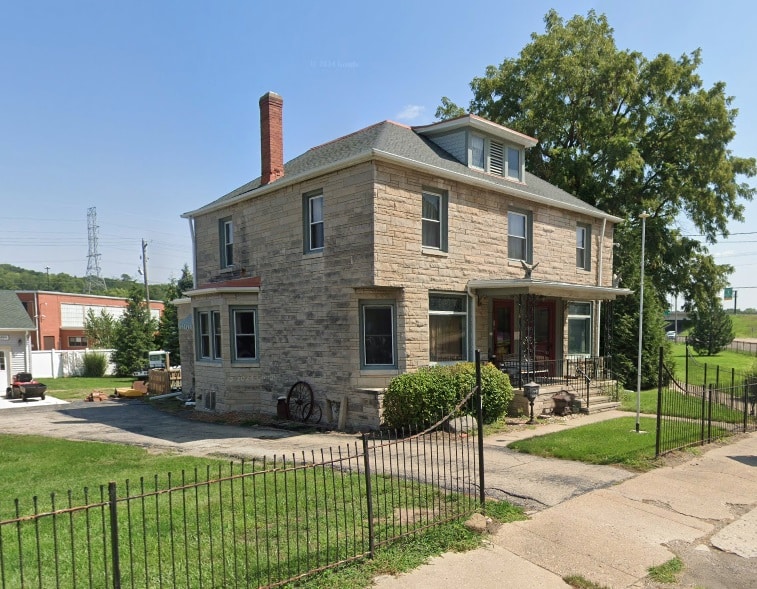This is a reprint of a “From the Local History Room” column that first appeared in Sept. 2013, before the launch of this weblog.
In days gone by, almost every town or village had its own blacksmith who manufactured and repaired metal tools and weapons and kept shoes on the townsfolk’s horses. With the societal shifts and technological advances of the 20th century, however, the old blacksmithing trade took a hard hit.
The village of Hopedale has the distinction of having been the home of what seems to have been Tazewell County’s last “old time” blacksmith. His name was Roy Neal “Buck” Roelofson (1876-1957). A short biographical sketch is included on pages 48-49 of Ruth Schilpp’s “Hopedale … My Home Town,” which also has some notes on Buck Roelofson’s family on page 496.
In fact, Schilpp’s 558-page book, a copy of which she donated to the Pekin Public Library in 1984, contains a wealth of information on Hopedale’s history. The following account of Buck Roelofson’s life is derived from her book, supplemented (and corrected on a point or two) by his Pekin Daily Times obituary and the Find-A-Grave website.
Buck Roelofson was born on April 15, 1876, in Hopedale, the first child of Ewing Patten and Fredricka Eliza (Capps) Roelofson. Ewing was born in Groveland Township in 1852. He and his family had moved to Hopedale when Ewing was just a child. One of Ewing’s brothers, R. D. Roelofson, was Hopedale’s first undertaker, but he left Hopedale in 1912 to become a circulation manager for the Bloomington Pantagraph. Ewing and Fredricka had four children, including a daughter, Mabel, who died when she was 11, and another daughter, Dorothy (1882-195_), who was a school teacher in Tazewell and Logan counties for 15 years.
Buck was a bachelor for most of his life. He did not marry until he was 61 years old, when he married Hazel Reinhart. They had no children together, but there were four children from Hazel’s prior marriage. Buck’s obituary does not list Hazel among his survivors, so she evidently had preceded him in death.
Schilpp says Buck Roelofson worked at the blacksmith trade for 58 years. In 1953, at the age of 77, he was still going strong, and that year he was interviewed for a story in the Pekin Daily Times. Schilpp writes:
“In 1953 when he was interviewed by the Pekin paper, he wanted everyone to know that he didn’t feel that the blacksmith trade was going out of existence.
“He looked around at a huge pile of plowshares, about sixty of them, just waiting for his attention. Some of the farmers would quit working in the fields just to wait on him to fix their plowshares.
“With the work piled knee-deep in his shop, he had a hard time trying to follow the doctor’s instruction to ‘take it easy.’ He said, ‘I suppose the day will come when I have to throw the hammer down, but I just don’t know what I would do.’ . . . .
“When asked about how he got started in the trade, he said, ‘I walked five miles every day and worked for nothing all one winter to learn the trade.’ Two years later he bought his boss out and went in business for himself. Through the years he became an expert in his field. He once told someone ‘I got them all beat, I even forge new plowshares that you aren’t supposed to be able to. You are only supposed to grind them but I forge them anyway and I can tell you they are shining when I get through with them.’
“People from as far away as twenty miles would come for his expertise in blacksmithing. He used acetylene welding, a forge and an assortment of hammers and grinding tools. He had another fixture around the shop. It was a cat that he described as ‘A NUISANCE’ but which he fed and took care of.
“As in all of the early businesses, there was a feeling of contentment – contentment of an artisan who knew his trade and loved what he was doing.
“Mr. Roelfson (sic) died in 1958 (sic). He was the last of the ‘old time’ blacksmiths.
“Mr. Durdle has that old desk that Mr. Roelfson had in his blacksmith shop for years.
“Mr. Harry Wertz took over this shop and operated it for a number of years. That building, which was located next to Mildred Hitts’ home on Third Street, burned down. Much history went up in smoke when that happened.”
It should be noted that there is a discrepancy over the year of Buck Roelofson’s death. Schilpp says it was 1958, and that is also what his grave marker says in Shiloh Cemetery, Hopedale. Nevertheless the true date of death was March 19, 1957, as we find in his obituary which was published the same day in the Pekin Daily Times.











